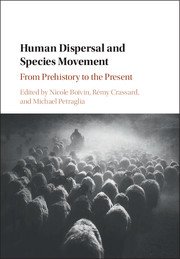Book contents
- Frontmatter
- Contents
- List of text boxes
- List of figures
- List of tables
- List of contributors
- Preface
- I Introduction
- 1 Human and human-mediated species dispersals through time: Introduction and overview
- II Origins: Species Movements in the Pleistocene
- III Across the water: Species movements by Coast and Sea
- IV Complexity: Species Movements in the Holocene
- V Invasion: The Movement of Invasive and Disease Species
- Index
- Plate section
- References
1 - Human and human-mediated species dispersals through time: Introduction and overview
from I - Introduction
Published online by Cambridge University Press: 04 May 2017
- Frontmatter
- Contents
- List of text boxes
- List of figures
- List of tables
- List of contributors
- Preface
- I Introduction
- 1 Human and human-mediated species dispersals through time: Introduction and overview
- II Origins: Species Movements in the Pleistocene
- III Across the water: Species movements by Coast and Sea
- IV Complexity: Species Movements in the Holocene
- V Invasion: The Movement of Invasive and Disease Species
- Index
- Plate section
- References
Summary
Homo sapiens is essentially an African primate. The vast majority of our evolution occurred in Africa, and the migrations of both our own species and ancestral human populations out of Africa are, in the grand scheme of things, relatively late-in-the-day occurrences. Nonetheless, we have not only travelled and settled beyond Africa, we have also achieved a global distribution unparalleled in other mammals (Gamble 2013; Finlayson 2014). From the most arid deserts to the iciest reaches of the frozen poles can be found human societies of diverse types and forms. And processes of dispersal, colonisation, and migration continue. Indeed, we now travel faster, further, and more often than ever before. In 2006, a staggering 4.4 billion people passed through the world's main airports (ACI 2007, cited in Hulme 2009: 13).
We have travelled far, but we have not travelled alone. Linked to the spread of human populations has been the geographic expansion of an extraordinary range of other species. These species have moved with humans, either directly, by way of our bodies, our caravans, our ships, and our roads, or indirectly by way of new routes opened up by our activities, for example, as we transform environments and accordingly provide pathways for new types of species to migrate and colonise. Much of this movement has been inadvertent, leading to the unintentional co-migration of a wide array of parasites, microbes, disease vectors, and invasive and commensal species. But we have deliberately carried with us a whole host of species as well, in particular the domesticated crops and animals that have enabled our astounding demographic success.
This book is about the extraordinary movements of humans across the globe, and the equally remarkable role that we and our ancestors have played in shaping the geographic dispersal of other species. It draws together contributors from diverse disciplines, whose research explores a broad range of species, time periods, and regions. The chapters collected here do not provide a comprehensive account of human dispersals and human-mediated species movements – such an undertaking would span many volumes and probably many lifetimes. Instead, they offer a broad range of illustrative examples that underscore the complex palimpsest of species movements through time.
- Type
- Chapter
- Information
- Human Dispersal and Species MovementFrom Prehistory to the Present, pp. 3 - 26Publisher: Cambridge University PressPrint publication year: 2017
References
- 4
- Cited by



